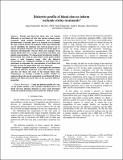| dc.contributor.author | Santorelli, Adam | |
| dc.contributor.author | Fitzgerald, Seán | |
| dc.contributor.author | Douglas, Andrew | |
| dc.contributor.author | Doyle, Karen M. | |
| dc.contributor.author | O’Halloran, Martin | |
| dc.date.accessioned | 2021-02-15T09:03:50Z | |
| dc.date.available | 2021-02-15T09:03:50Z | |
| dc.date.issued | 2020-07-20 | |
| dc.identifier.citation | Santorelli, Adam, Fitzgerald, Seán, Douglas, Andrew, Doyle, Karen M., & O’Halloran, Martin. (2020). Dielectric profile of blood clots to inform ischemic stroke treatments. Paper presented at the 42nd Annual International Conference of the IEEE Engineering in Medicine & Biology Society, EMBC 2020 (via the EMBS Virtual Academy), Montréal, Canada, 20-24 July. DOI: 10.1109/EMBC44109.2020.9175387 | en_IE |
| dc.identifier.uri | http://hdl.handle.net/10379/16554 | |
| dc.description.abstract | Platelet and fibrin-rich blood clots can respond
differently to red blood cell rich clots during ischemic stroke
treatment, which includes thrombolysis and mechanical
thrombectomy. Currently, there is no accurate way to identify
the type of clot in advance of treatment. If the type of blood clot
can be identified, the optimum clot removal process can be
chosen and patient outcomes can be improved. In this paper we
fabricate physiologically relevant blood clot analogues from
human blood, that cover a range of red blood cell, fibrin, and
platelet concentrations. We characterize the dielectric profile of
these formed clots using an open-ended coaxial probe method
across a wide frequency range. After the dielectric
measurements are completed, histology on each blood clot is
performed to determine the concentration of red blood cells
present. In total, 32 unique blood clots were measured.
With this completed analysis, we investigate the correlation
between the dielectric properties across this frequency range
and the red blood cell count of the formed blood clots.
Furthermore, we develop a model to predict whether an
unknown blood clot can be categorized as red blood cell rich or
platelet and fibrin-rich based solely on the measured dielectric
properties. | en_IE |
| dc.format | application/pdf | en_IE |
| dc.language.iso | en | en_IE |
| dc.publisher | IEEE | en_IE |
| dc.relation.ispartof | EMBC 2020 Montreal | en |
| dc.rights | Attribution-NonCommercial-NoDerivs 3.0 Ireland | |
| dc.rights.uri | https://creativecommons.org/licenses/by-nc-nd/3.0/ie/ | |
| dc.subject | Dielectric profile | en_IE |
| dc.subject | blood clots | en_IE |
| dc.subject | ischemic stroke treatments | en_IE |
| dc.subject | Coagulation | en_IE |
| dc.subject | Dielectrics | en_IE |
| dc.subject | Dielectric measurement | en_IE |
| dc.subject | Red blood cells | en_IE |
| dc.subject | Probes | en_IE |
| dc.subject | Permittivity | en_IE |
| dc.title | Dielectric profile of blood clots to inform ischemic stroke treatments | en_IE |
| dc.type | Conference Paper | en_IE |
| dc.date.updated | 2021-02-15T07:57:51Z | |
| dc.identifier.doi | 10.1109/EMBC44109.2020.9175387 | |
| dc.local.publishedsource | https://dx.doi.org/10.1109/EMBC44109.2020.9175387 | en_IE |
| dc.description.peer-reviewed | peer-reviewed | |
| dc.internal.rssid | 24774984 | |
| dc.local.contact | Karen Doyle, Dept. Of Physiology, Human Biology Building, Nui Galway. 3665 Email: karen.doyle@nuigalway.ie | |
| dc.local.copyrightchecked | Yes | |
| dc.local.version | ACCEPTED | |
| nui.item.downloads | 204 | |


